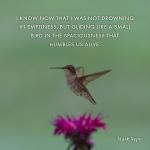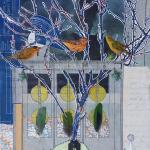Who is behind the mask?
The Practice
See the person behind the eyes.
Why?
Most of us wear a kind of mask, a persona that hides our deepest thoughts and feelings, and presents a polished, controlled face to the world.
To be sure, a persona is a good thing to have. For example, meetings at work, holidays with the in-laws, or a first date are usually not the best time to spill your guts. Just because you’re selective about what you reveal to the world does not mean you’re insincere; phoniness is only when we lie about what’s really going on inside.
Much of the time, we interact mask-to-mask with other people. There’s a place for that. But remember times when someone saw through your mask to the real you, the person back behind your eyes. If you’re like me, those times were both unnerving and wonderful.
Even though it’s scary, everyone longs to be seen, to be known. To have your hopes and fears acknowledged – the ones behind a polite smile or a frown of frustration. To have your true caring seen, as well as your positive intentions and natural goodness. Most intimately of all, to feel that your innermost being – the one to whom things happen, the one strapped to this rollercoaster of a life trying to make sense of it before it ends – has been recognized by someone.
This goes both ways: others long to be seen by you. Besides the ways that seeing the person behind the eyes benefits others, it’s good for you, too. Being seen is often the real stake on the table, the top priority, more important to other people than whether you agree with them about something. When someone gets that sense from you, that he or she exists for you as a person- not just as a pain in the neck or as someone to manage to get through this meeting, dinner, bedtime routine, phone call, or sexual experience – then it’s much easier to take care of the matter at hand, whatever it is.
Sensing the deepest layers in people can nourish you in other ways, too. For example, I had a relative with a big heart but a difficult personality that drove me a little crazy. Finally, I started to imagine that being with her was like looking at a bonfire through a lattice covered with thorny vines. I focused on the love shining through and warming my own heart, and didn’t get caught up in the vines. That helped both of us a lot.
How?
This week with different people, get a sense of the person behind the eyes. It’s not a staring contest; it can actually help to look away so you’re not distracted by surface details. (While I’m using the word “see,” of course you are also hearing the person behind the words, sensing the person embedded in the body sitting across from you.)
Take a moment to relax and set aside your case about the other person, and open to the being down in there somewhere, maybe rattled and defensive and acting in ways that are problematic, but really just yearning for happiness and some way to move forward in life.
You could also sense your own innermost being, and then imagine that core, that sense of being alive, the recipient of experiences, the one for whom life is hard sometimes, inside the other person.
Let that recognition of the person over there show in your face, in your own eyes. Be brave and let them see you seeing them.
Notice how this recognition changes the course of an interaction – perhaps softening it, making it more authentic, leading to a good resolution more gently and quickly.
As an advanced practice, you could even raise the subject with someone, of the degree to which you feel seen (or not) as persons by each other. That kind of conversation can transform a relationship.
Last, enjoy being a person yourself, the channel through which your life streams – with some of the richest streaming being the other persons all around you.
* * *
Rick Hanson, Ph.D., is a neuropsychologist and founder of the Wellspring Institute for Neuroscience and Contemplative Wisdom. His work has been featured on the BBC, NPR, Consumer Reports Health, U.S. News and World Report, and Huffington Post, and he is the author of the best-selling Buddha’s Brain: The Practical Neuroscience of Happiness, Love, and Wisdom. He writes a weekly newsletter – Just One Thing – that suggests a simple practice each week that will bring you more joy, more fulfilling relationships, and more peace of mind and heart. If you wish, you can subscribe to Just One Thing here.
















